 Without a doubt, getting to Trieste this was the worst travel day we’ve had in a long time. We started at 8:30am from our villa in Puglia and finally arrived to our hotel in Trieste a little after 11pm, almost 15 hrs. later. We thought it would take about 8.5hrs. Between the really bad drivers, flight delay, rain and rush hour traffic that lasted from Milan Malpensa all the way through Brescia, we were wiped out by the time we got to the hotel.
Without a doubt, getting to Trieste this was the worst travel day we’ve had in a long time. We started at 8:30am from our villa in Puglia and finally arrived to our hotel in Trieste a little after 11pm, almost 15 hrs. later. We thought it would take about 8.5hrs. Between the really bad drivers, flight delay, rain and rush hour traffic that lasted from Milan Malpensa all the way through Brescia, we were wiped out by the time we got to the hotel.
We’d booked a nice room overlooking the Bay of Trieste but we were tired and we really didn’t want to check into the “really charming” tiny room. As soon as we checked in we asked for an upgrade to a jr suite. There were a lot of hmmmmms and mmmmms as three people pressed a lot of keys on the computer keyboards. Then, the front desk manager looked up at us and with a totally straight face said, “we can offer you the Presidential Suite, would this be OK?” We both smiled and said “yes! but what is the cost?” He just waved his hand and replied we are giving you an upgrade, don’t worry about it.
The suite is amazing. The bathroom alone is around 200 sq. ft. There is a large living room, a bed so large I couldn’t find Gretchen the following morning and three enormous window balconies looking over the Bay. What a reward for a bad drive.
Trieste
There was a poll taken in 1999 where 70% of all Italians didn’t know Trieste was in Italy. It’s a beautiful harbor city of around 200,000 and I can’t figure out why more people don’t come here. The city is very close to the border of Slovenia and the culture here is a great mixture of Italian, Austrian, Slovenian and Croatian. The food varies from fresh fish to pasta and goulash.
From the mid 14th century till 1918, this was one of the Austrian Habsburg greatest port cities and was once a rival for naval supremacy in the Adriatic with Venice.
Sir Richard Burton (explorer, diplomat and translator of erotic literature including The Thousand Arabian Knights) was the British Consul here in 1870. That must have been a fun time.
James Joyce wrote “A portrait of an Artist as a Young Man” here and drafted much of Ulysses while he lived here from 1904-1915.
Jules Verne lived here and wrote his 1885 epic “Mathias Sandorf” about a conspiracy to liberate Hungary from Austrian rule and how Count Sandorf avenged the deaths of his co conspirators.
Sigmund Freud spend time here and supposedly performed the first psychoanalysis in Trieste.
Adolf Eichmann escaped through Trieste at the end of World War II.
This was Graham Greene’s city of spies where con artist and double agent Harry Lime (the Third Man) would hang out during the 1940’s. I’m sure there were many more spies hanging out here during the cold war of the 1950s-1990s and throughout the Balkan Wars of the 1990s. We were told that during the Balkan Crisis, most Italians thought the battles were being fought in Trieste and consequently stayed away.
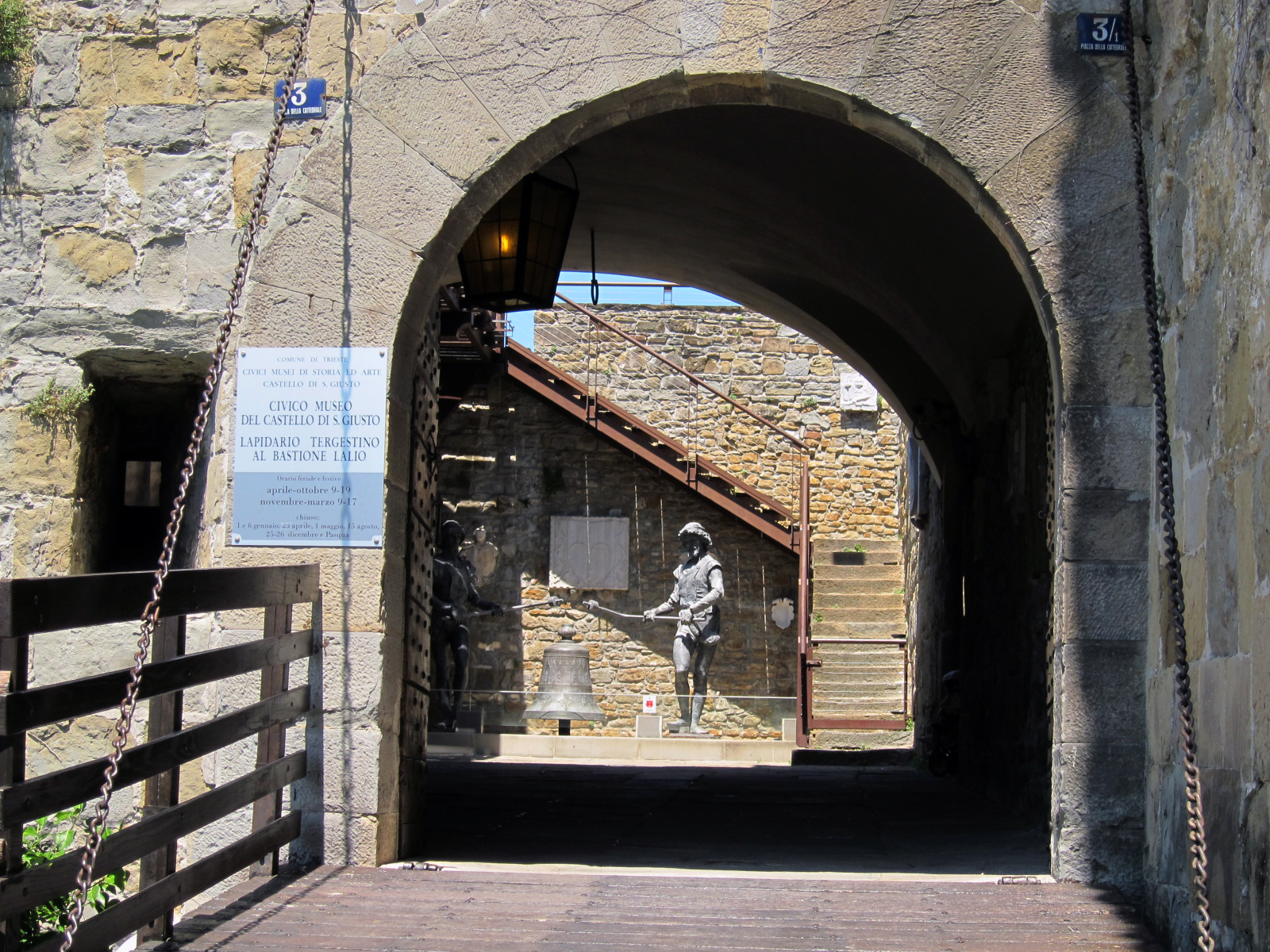 We started our first day with a tour of the historic old city. It’s a pleasant walk up the hill to the Castle San Giusto. The Castle has been built over many times but the Captains House inside the castle walls still keeps the flavor of the old Austrian Hapsburg era. The rest of the place is used as vista views and concerts in the old fortress assembly yard.
We started our first day with a tour of the historic old city. It’s a pleasant walk up the hill to the Castle San Giusto. The Castle has been built over many times but the Captains House inside the castle walls still keeps the flavor of the old Austrian Hapsburg era. The rest of the place is used as vista views and concerts in the old fortress assembly yard.
 The Trieste Cathedral di San Giusto was built over a roman forum. There are still some of the remains between the Cathedral and the Castle. There is also a Roman Amphitheater on the San Giusto Hill built under the Emperor Octavian between 33-32 BC. He really didn’t become Emperor Augustus Caesar till 27BC.
The Trieste Cathedral di San Giusto was built over a roman forum. There are still some of the remains between the Cathedral and the Castle. There is also a Roman Amphitheater on the San Giusto Hill built under the Emperor Octavian between 33-32 BC. He really didn’t become Emperor Augustus Caesar till 27BC.
The art historian Johann Joachim Winkelmann, known to most as “the father or founder of archeology” was killed in Trieste in 1768, murdered in bed in a hotel by another traveler who wanted the medals he was wearing. He was 51 years old when he died. Winkelmann was the first historian to understand the difference between Greek and Roman artifacts. He’s also responsible for much of the salvation of the ancient monuments we are fortunate to still see today. He was awarded many titles and accolades and shinny awards for his efforts. He also must have been a pretty cheap guy and opted to share a room with an unknown quest instead of a private room in a hotel. The unknown guest proved to be his undoing. Winkelmann is buried in the courtyard of the Trieste Cathedral.
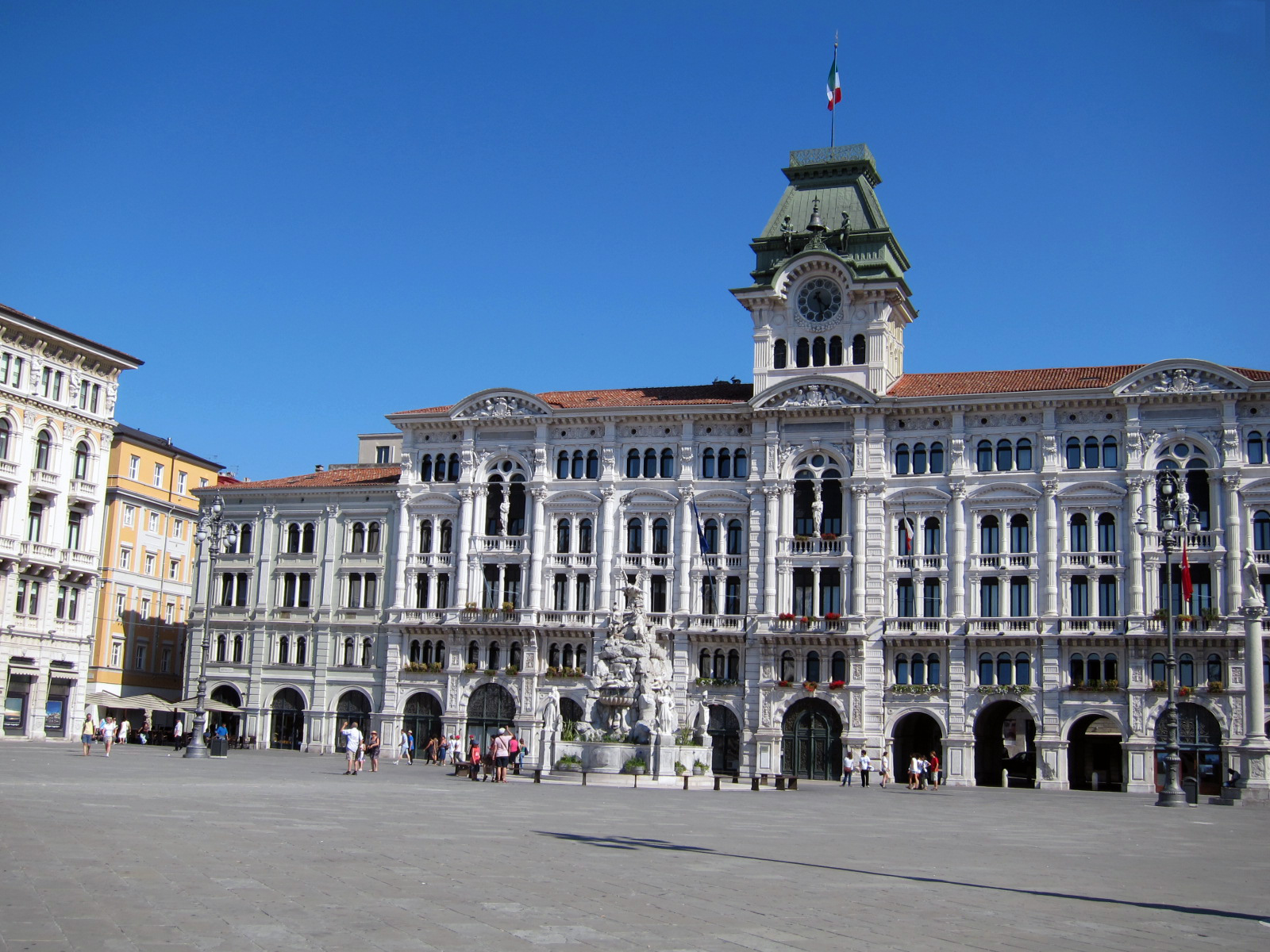 Our hotel, the Savoie Palace Hotel is a block away from the Piazza Unita d’Italia; one of Italy’s largest and most beautiful squares. The Palazzo del Commune is topped by a clock tower where (like in Venice) two Moors ring in the hours.
Our hotel, the Savoie Palace Hotel is a block away from the Piazza Unita d’Italia; one of Italy’s largest and most beautiful squares. The Palazzo del Commune is topped by a clock tower where (like in Venice) two Moors ring in the hours.
The grid around the square along the Corso d’Italia, Via San Niccolo and Via Mazzini is packed every night with Happy Hour patrons sipping beer and Aperol Spritz or just walking through the shops that stay open till 9pm, later on Saturdays.
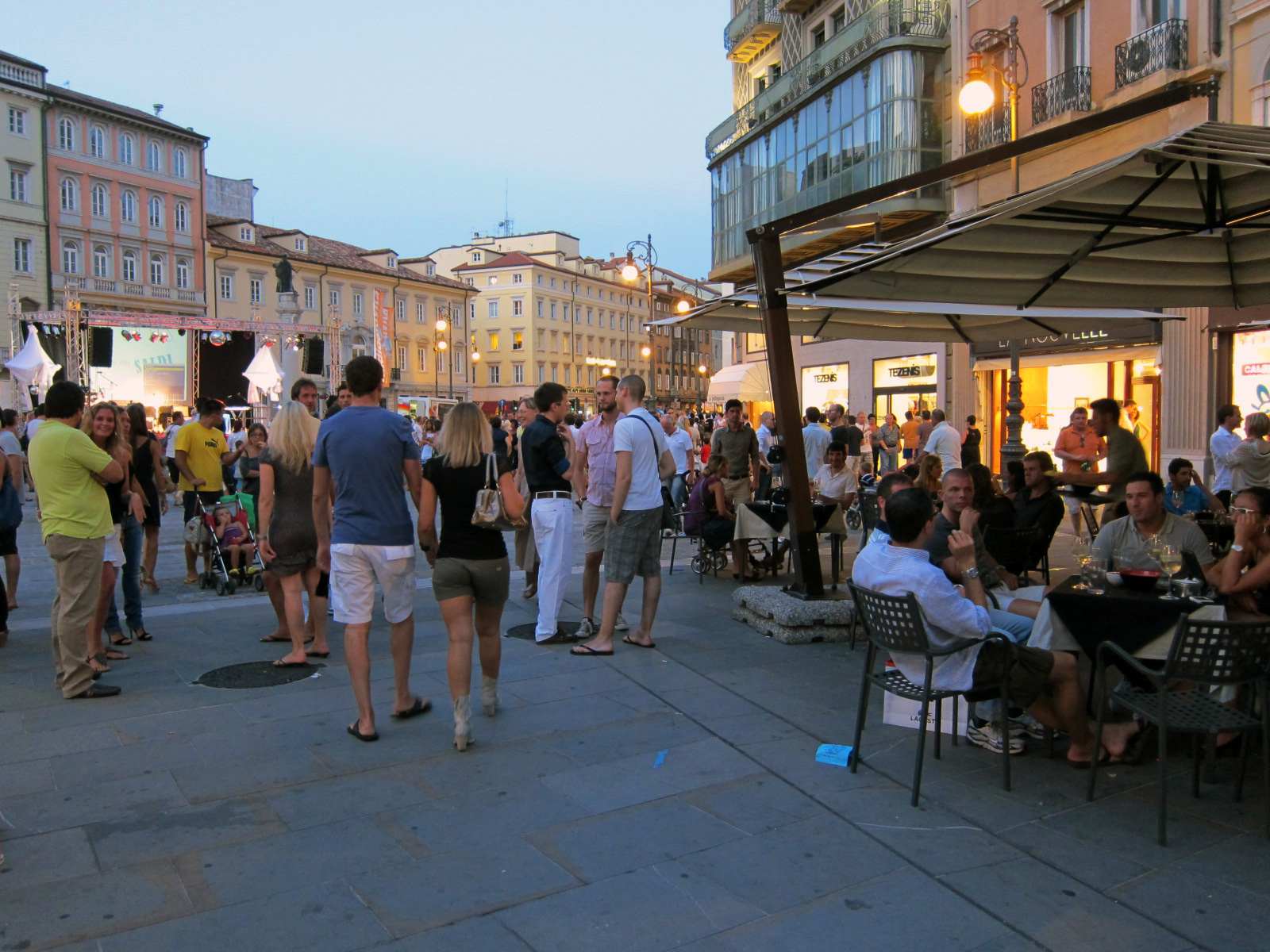 It’s really fun here. Out Italian is good enough but most of the people speak a dialect called Friulian, a mixture of Italian, Slovenian and Croatian.This part of the Europe has changed hands so many times in the last 100yrs they’ve kind of created their own culture.
It’s really fun here. Out Italian is good enough but most of the people speak a dialect called Friulian, a mixture of Italian, Slovenian and Croatian.This part of the Europe has changed hands so many times in the last 100yrs they’ve kind of created their own culture.
Trieste is a pretty good size economic center. Many of the International cruise ships are built near here and more than 40% of the coffee coming into Italy comes through Trieste. The city is the home to Illy café and we’ve been drinking a lot of it.
Although Trieste is the main city of the Friuli, Udine is the historic capitol.
The Piazza Libertà has the feel of Piazza San Marco in Venice, well similar architecture. Venice took the city in the 16th century. In the Piazza is the very Venetian Loggia di Lionello Town Hall) (1448-1457). Across the square is the Loggia di San Giovanni (with two Venetian inspired bell tower Moors). The Lionello of the Town Hall (by the way) refers to a local goldsmith, Nicolo Lionello, who sponsored the project, not the lions on the building.
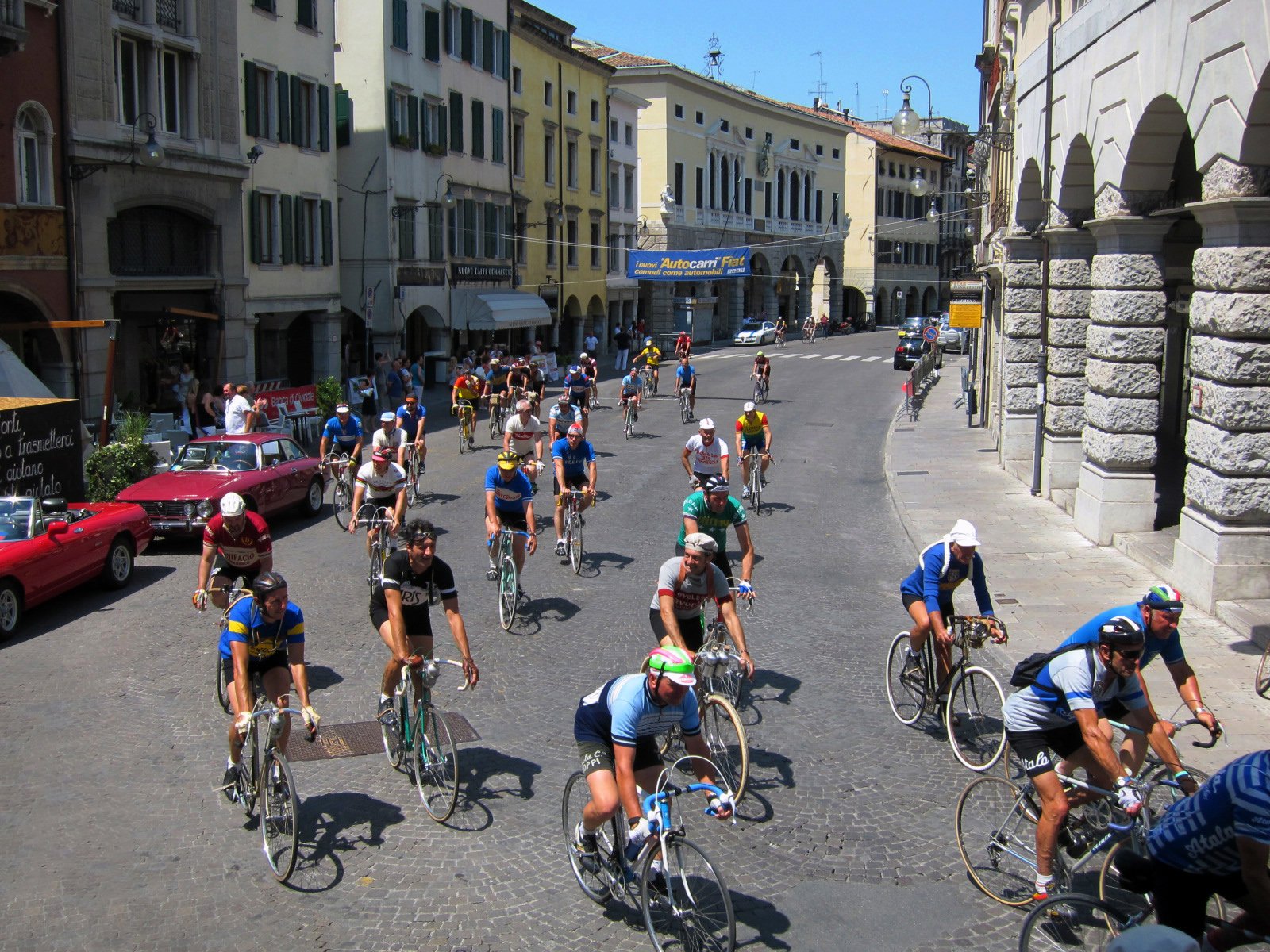 It was Sunday in Udine when we arrived and although most of the city was closed we just happened upon the Corsa d’Epoca, an 80km bicycle race up and down the Friulian hills and ended in front of the The Santa Maria della Purità Church (designed by Palladio with interior frescos by Tiepolo). The cyclists were followed by vintage cars and motorcycles. We saw a 1951 Vespa, everything was “completely original”. The owner even told me that he had to replace the gear box but through the internet he found an original one in Poland and had it shipped to Italy. It cost him 230€ for the small part but he said everything on the bike must be original.
It was Sunday in Udine when we arrived and although most of the city was closed we just happened upon the Corsa d’Epoca, an 80km bicycle race up and down the Friulian hills and ended in front of the The Santa Maria della Purità Church (designed by Palladio with interior frescos by Tiepolo). The cyclists were followed by vintage cars and motorcycles. We saw a 1951 Vespa, everything was “completely original”. The owner even told me that he had to replace the gear box but through the internet he found an original one in Poland and had it shipped to Italy. It cost him 230€ for the small part but he said everything on the bike must be original.
It’s an easy walk up the hill to the castle, a large 16th century Palazzo style building build over an old Lombard Castle. Legend says the mound under the Castle was built by Hun warriors, filling their helmets with soil and piling up a mound high enough so that Attila could get a good look at the fires coming from the Roman city Aquileia as his troops were burning it to the ground.
The current Castle still has beautiful ceiling frescos and grand rooms but these days it’s used as an art gallery so your attention is pretty much fixed to the walls, unless you happen to look up. There was an exhibit of Giambattista Tiepolo’s early works, Amazing stuff.
 From Udine we were hungry and decided to drive over to San Daniele del Friuli for a prosciutto lunch. Every June they hold the Aria di Festa, a festival about ham, but this was a Sunday in July and everything was pretty quiet, except for a motorcycle rally getting ready to start up in front of the Church of Sant’Antonio. We sat on the terrace of a Prosciutteria and had San Daniele prosciutto with melon and figs. It was incredibly delicious of course, but we also learned a lot about San Daniele Prosciutto. The true color of the best San Daniele is pink. The waiter explained to us that when the pig has more fat the meat is pink and much sweeter. The darker the meat, the less fat and the less the taste. He was right. Pink is the way to go.
From Udine we were hungry and decided to drive over to San Daniele del Friuli for a prosciutto lunch. Every June they hold the Aria di Festa, a festival about ham, but this was a Sunday in July and everything was pretty quiet, except for a motorcycle rally getting ready to start up in front of the Church of Sant’Antonio. We sat on the terrace of a Prosciutteria and had San Daniele prosciutto with melon and figs. It was incredibly delicious of course, but we also learned a lot about San Daniele Prosciutto. The true color of the best San Daniele is pink. The waiter explained to us that when the pig has more fat the meat is pink and much sweeter. The darker the meat, the less fat and the less the taste. He was right. Pink is the way to go.
With our bellies filled with pork, we drove back south to the War Monument at Redipuglia, very close to the Friuli Venezia Giulia airport.
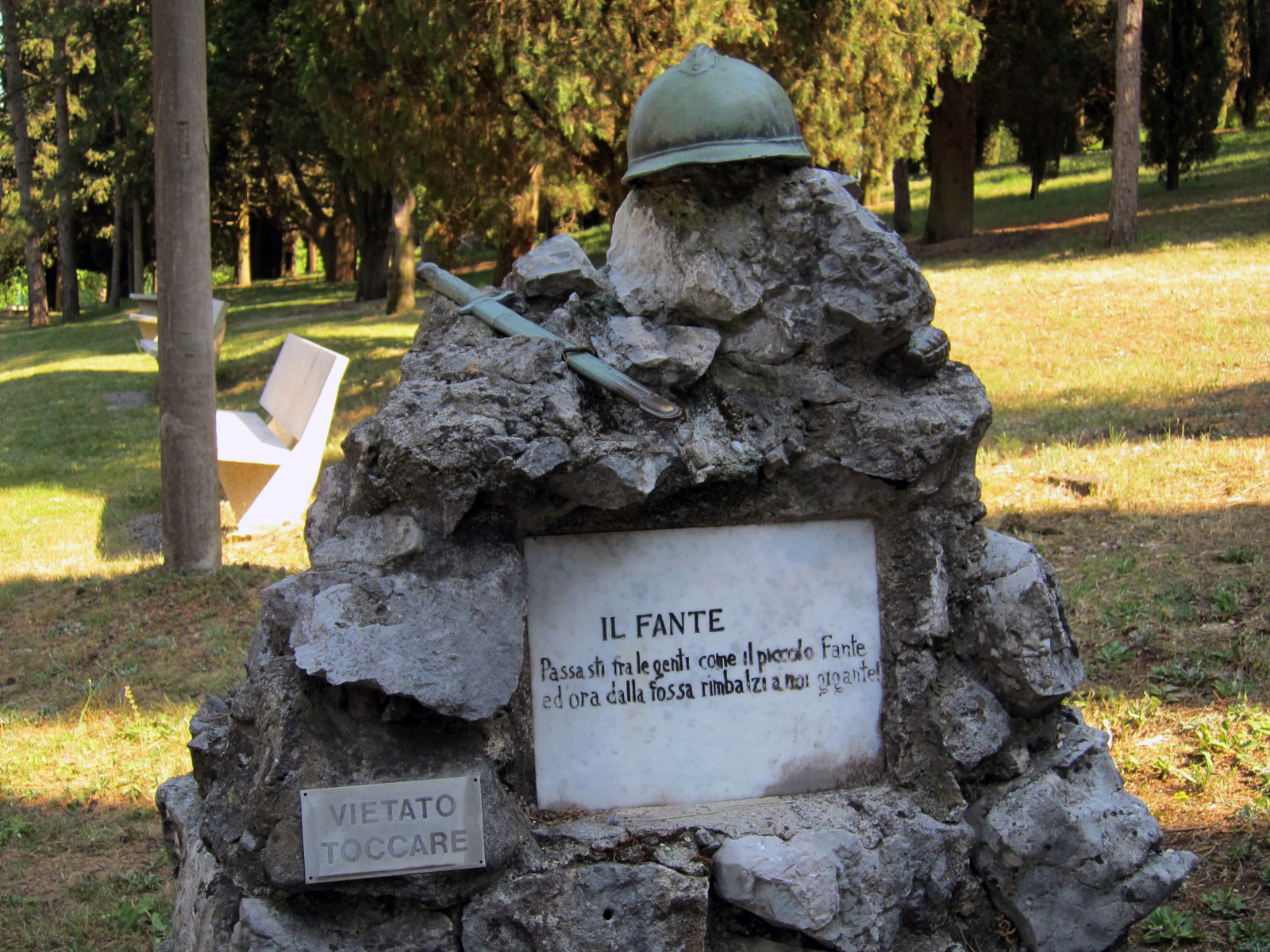 Redipuglia and the War memorials
Redipuglia and the War memorials
There are many who state that the sole reason for Italy to enter World War One was to extend her boundaries in the north. They did get back Friuli Venizia Giulia although it was a pyrrhic victory. They suffered the loss of 1.25 million deaths in order to secure an area that has only 1.2 million people. Half of the casualties, close to 600,000 were lost along the 60 mile long valley of the Isonzo River near Udine on the border between Friuli and Slovenia, running from the Julian alps south to the Adriatic sea.
There were 12 battles in the Isonzo Campaign between 1915 and ending in 1917. The last one, the Battle of Caporetto (24 October – 7 November 1917) was the worst disaster for the Italians. The bad weather, poison gas, German storm troopers and superior German artillery ended in 11,000 killed, 20,000 wounded and 265,000 taken prisoner. No number is given to thousands who deserted. At some estimate over 9,000 prisoners were taken in a day. The name “Caporetto” became synonymous with the worst kind of defeat. It is still occasionally mentioned when the outcome of an act appears catastrophic.
The huge stepped 1938 war memorial contains the corpses of 39,857 identified Italian soldiers, and 69,330 unidentified. In a nearby cemetery another ±14,000 Austro-Hungarian soldiers are buried. The park also includes poetic monuments to those lost in battle, trench fortifications and a couple WWI artillery canons.
Hemmingway drove an ambulance during the Isonzo war battles and wrote about it “A Farewell to Arms”. There are monuments to the Isonzo battles all over the area. Redipuglia is by far the largest.
During World War II, most of the fighting in this area was between the Yugoslavian Partisans and Nazis. When the Partisans finally took Trieste June 1945, the enemy shifted from the Nazis to the Nazi collaborators and Fascist party members. It was a pretty bloody period. Many were sent to Yugoslavian concentration camps or just killed and thrown into pits along the Karst plateau.
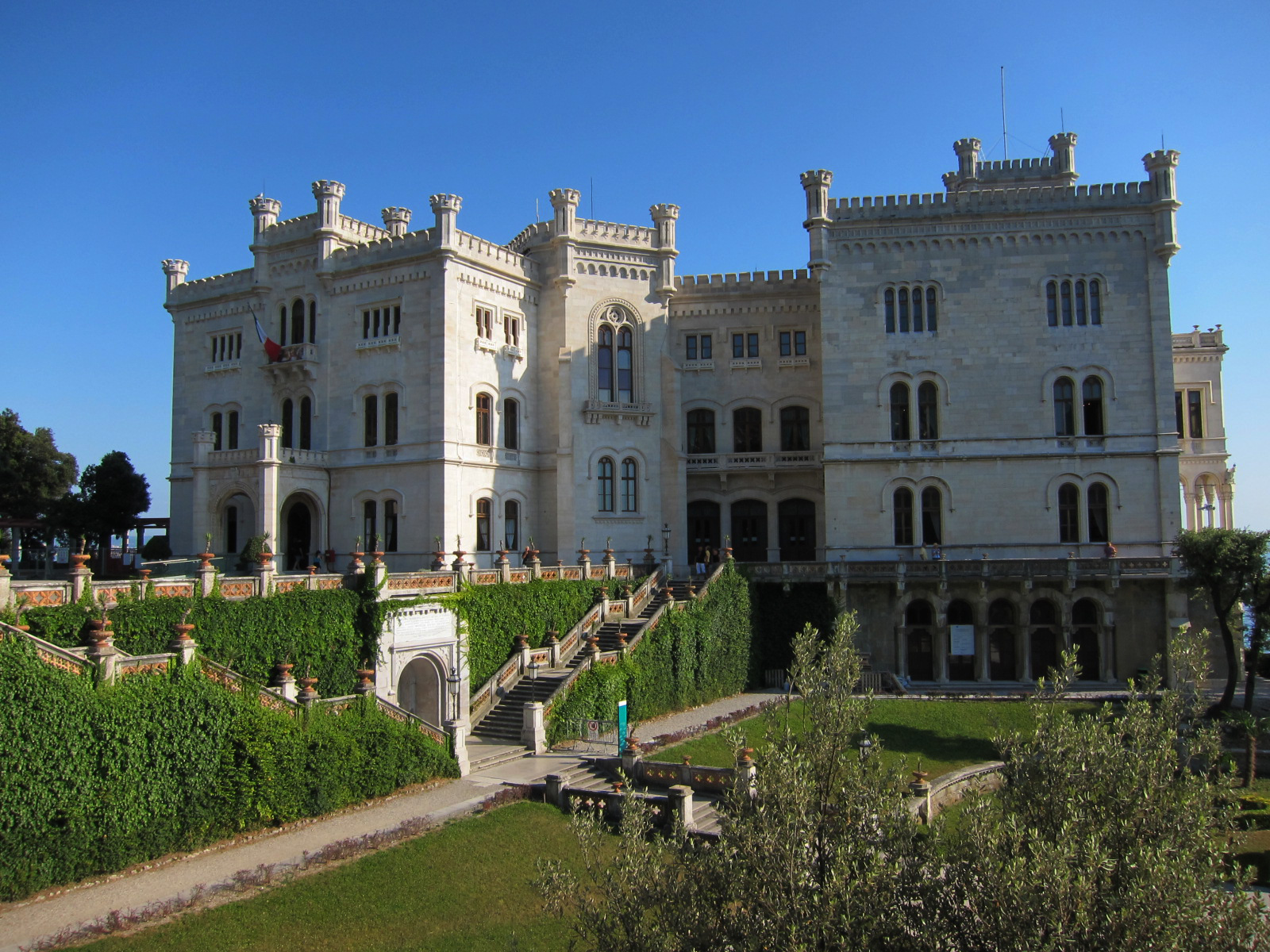 We tried to leave our sadness back at the memorials and headed back towards the city. The route in and out is the SS14, a really beautiful tree lined street with silver stone cliffs on one side and the sea on the other. The SS14 also goes right by the Miramar Castle, one of the landmarks of Trieste. Its about 8km from the center of the city.
We tried to leave our sadness back at the memorials and headed back towards the city. The route in and out is the SS14, a really beautiful tree lined street with silver stone cliffs on one side and the sea on the other. The SS14 also goes right by the Miramar Castle, one of the landmarks of Trieste. Its about 8km from the center of the city.
Archduke Maximillian, the brother of Emperor Franz Joseph I of Austria had this summer palace built between 1856-1860. He lived here for a couple of years before he was crowned the Emperor of Mexico in 1864, which didn’t turn out too well for him. In 1867, three years later, he was overthrown by Benito Juarez and executed by a firing squad. Soon after, the castle got a reputation as a cursed place on anyone who slept there, especially since it was the last place Archduke Franz Ferdinand slept before he was assassinated in Sarajevo in 1914. When the Americans took over the Castle in 1946, the commander was so superstitious, he slept outside on the grounds in a tent.
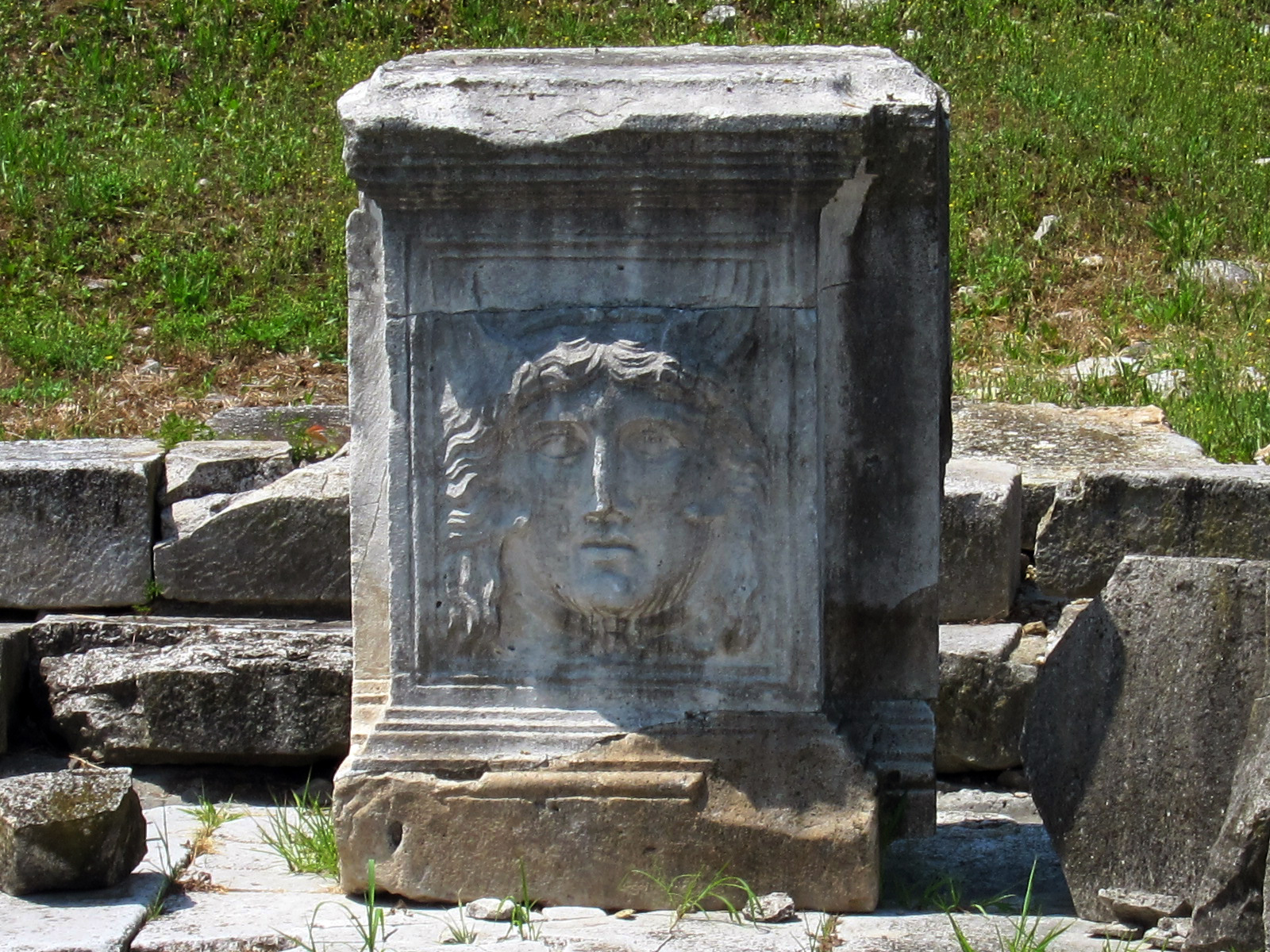 Today we went back in history to the small town of Aquileia, the town Attila the Hun watched burn from the top of Udine.
Today we went back in history to the small town of Aquileia, the town Attila the Hun watched burn from the top of Udine.
From around 180BC to the 3nd century AD this was the largest Roman city in the area, over 200,000 citizens. It was a major port town with a 45 meter wide river running from the Mediterranean port of Grado. The remains of the shipping warehouses and loading/unloading apparatus are still very visible along what is now known as the Via Sacra, even though the river is not.
In the 5th century it was sacked by Attila, then the Lombards and then when the Natiso river dried up near Grado, there went the port. There was no reason for the town any longer. Modern day Aquileia has about 3500 people living here, mostly farming grapes for wine.
Grado survived a little better. It still has a small ancient quarter, but since the 19th century, its mostly known for a fresh water spring with magical properties to cure TB. Emperor Franz Joseph of Austria was one of the patients and once you get a royal of that importance, the rest come flowing through. Once the town figured out the waters really didn’t work, it didn’t dissuade them. They just moved to some other treatment, including the famous sand-cure, where you get buried in the healing sand of Grado.
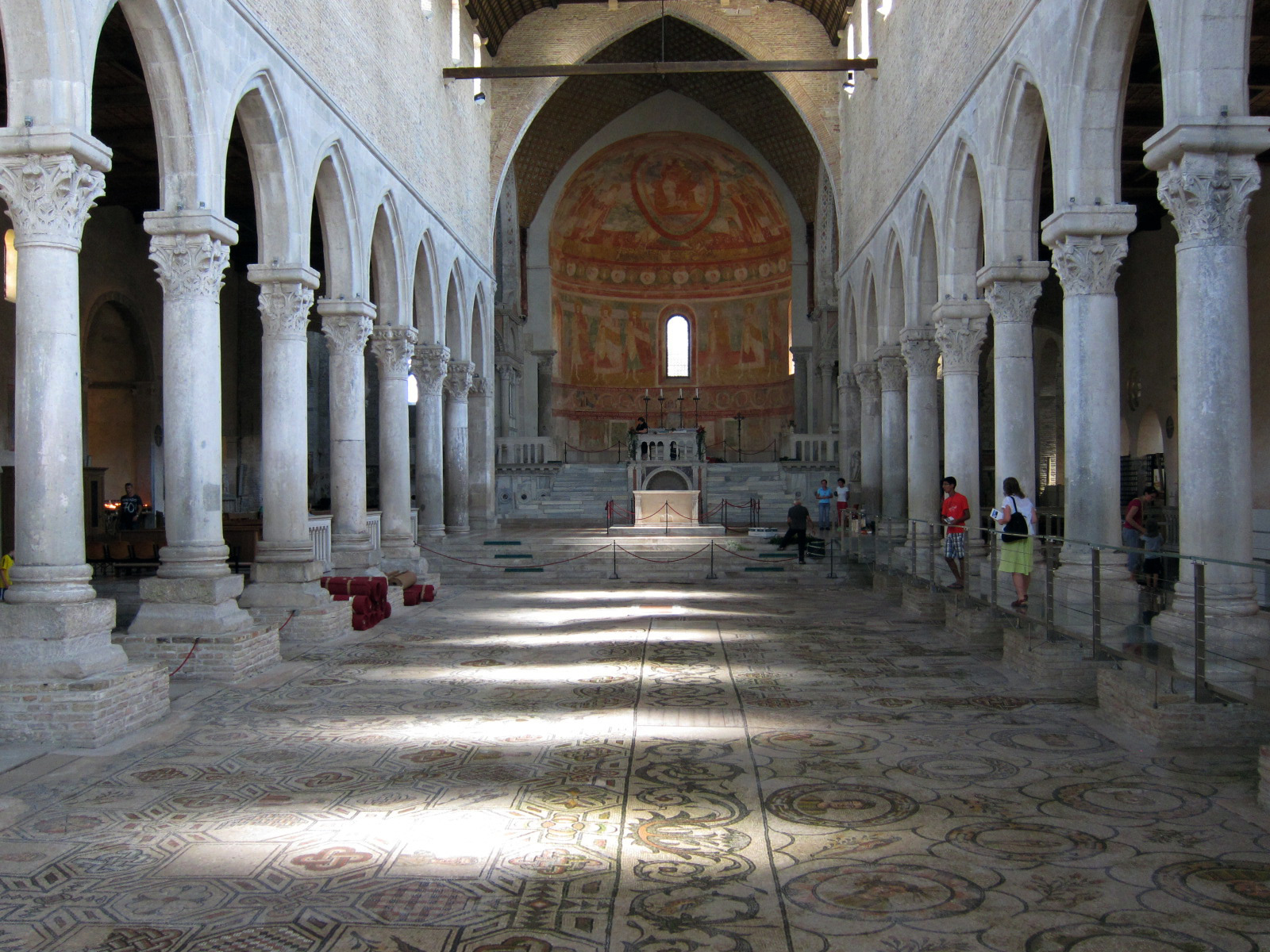 The real treat here though is inside the Cathedral of Aquileia. The original Church goes back to the 4th century. The current cathedral was built in 1023 and rebuilt again in 1379.
The real treat here though is inside the Cathedral of Aquileia. The original Church goes back to the 4th century. The current cathedral was built in 1023 and rebuilt again in 1379.
When the 1023 church was built, the architect, Patriarch Poppone covered up the original 313 Byzantine mosaic floor with a newer, more contemporary geometric design. Lucky for us, in 1909 when work was being done on the Cathedral, the 4rd century floor was rediscovered, totally intact.
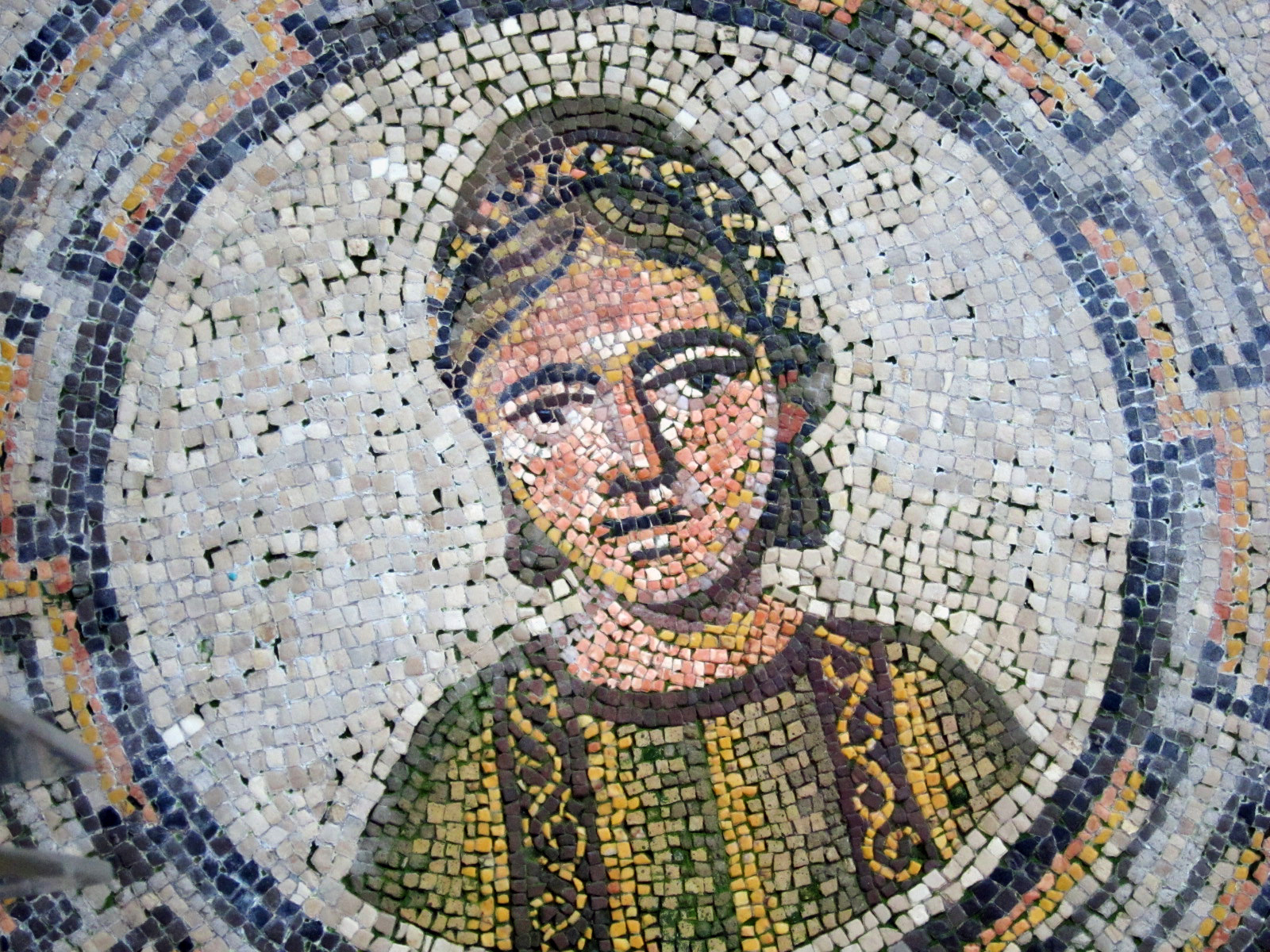 There are 837 sq. yards of it, the largest Paleochristian mosaic in the world. There are portraits of the families who paid for the floor, animals and geometric patterns , fables relating to the miracles of Jesus Christ, all mingling with ancient pagan symbols. It’s truly a “wow” moment just walking into the Cathedral.
There are 837 sq. yards of it, the largest Paleochristian mosaic in the world. There are portraits of the families who paid for the floor, animals and geometric patterns , fables relating to the miracles of Jesus Christ, all mingling with ancient pagan symbols. It’s truly a “wow” moment just walking into the Cathedral.
Aside from the mosaic floor, there are some very good 11th -15th century frescos in the apse and the crypt.
Behind the Church is a really beautiful memorial graveyard to those who lost their lives in the Isonzo River battles of WWI. It’s more personal, small bronze crosses all with the same expression of how the most noble death is to die for your country.
 On our way back to Trieste we decided to cool off and head down into the Grotta Gigante. This giant cave (374 ft. high, 3,031 ft. long and 213 ft. wide) is about 10km from Trieste in the Italian side of the Karst rock formation. It was listed in the 1995 Guinness book of records as the largest tourist cave in the world. There are a pair of stalactites that measure 346 ft. tall.
On our way back to Trieste we decided to cool off and head down into the Grotta Gigante. This giant cave (374 ft. high, 3,031 ft. long and 213 ft. wide) is about 10km from Trieste in the Italian side of the Karst rock formation. It was listed in the 1995 Guinness book of records as the largest tourist cave in the world. There are a pair of stalactites that measure 346 ft. tall.
All visitors are not allowed to stray off the path or to touch anything. Humans carry all kinds of bacteria and fungus that can really screw up an environment like this. It’s 500 steps down (about 100 meters) and 500 back up, and we didn’t even get to the bottom. The cave is comprised of various kinds of rock, some with strange patches of mold. Our guide informed us that the mold spores were brought into the cave by human tourists and they are able to grow with just the light from the incandescent path lamps.
The museum display at the entrance tells us history of bats. There are 1200 species in the world and 35 of the live in Italy. They’ve found bat fossils dating back 52 million years. They even talk about how a bat’s heart beats 1000 beats per minute. We expected to see a lot of bats. But sorry. When the second cave opening was completed in 1995, the bats all disappeared and moved to another cave.
There are no signs of any proteus salamanders there either. The proteus is a blind amphibian salamander, sometimes called the human fish because of the color of its skin. Even though it’s only about 12” long, it’s still the largest troglodyte amphibian in the world. It needs water to survive and the only water in Grotta Gigante these days is dripping condensation.
There are two +375’ long scientific pipes running through the cave height. They, according to our guide, measure the earth’s movement based on metrological events like snow in the Alps, rising tides in the oceans, tsunamis and earthquakes.
And probably the silliest and touristy part of the tour was the 12’ tall skeleton of a 12,000 yr. old bear that was reassembled from bones found in the cave.
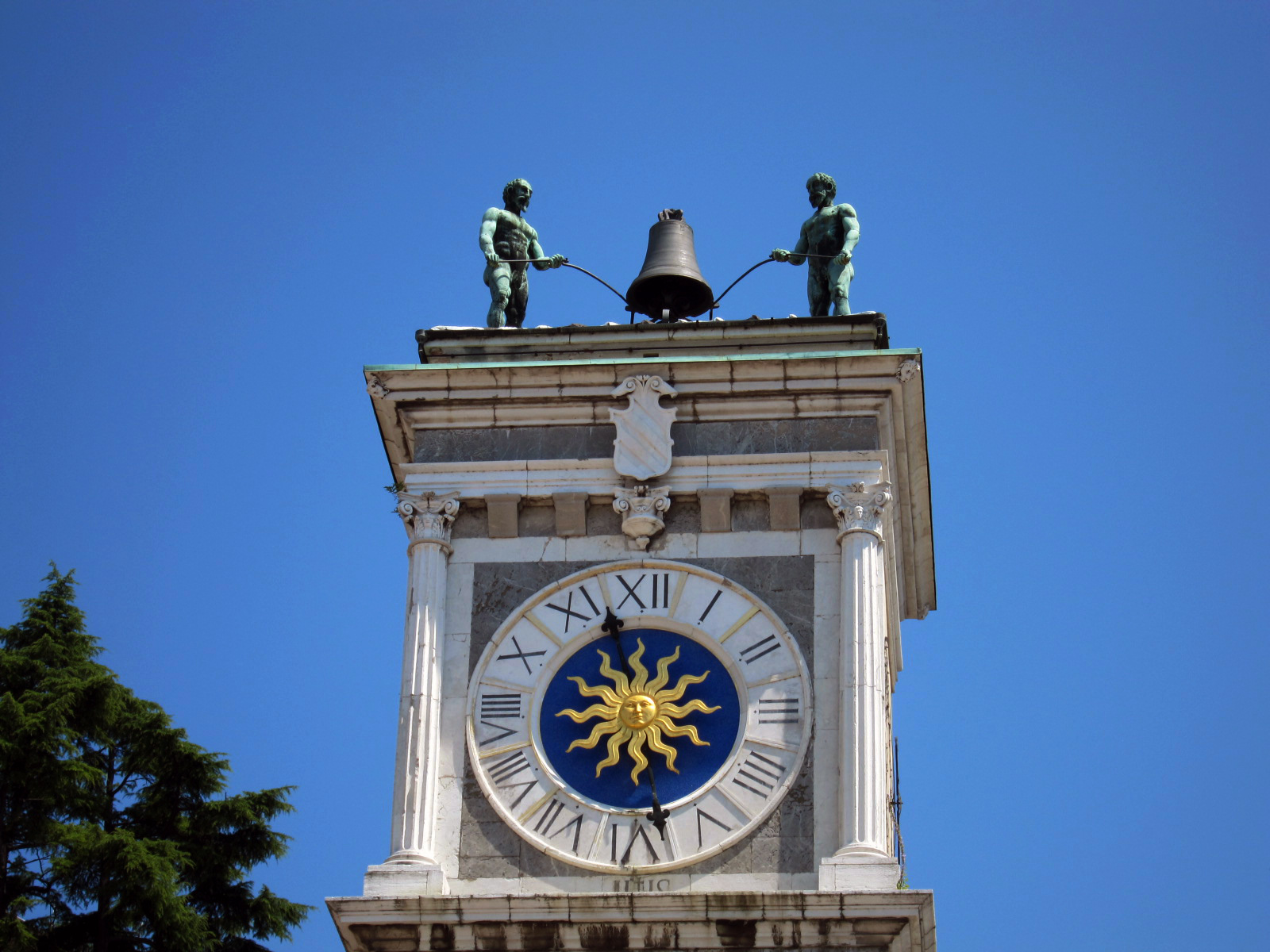
You must be logged in to post a comment.